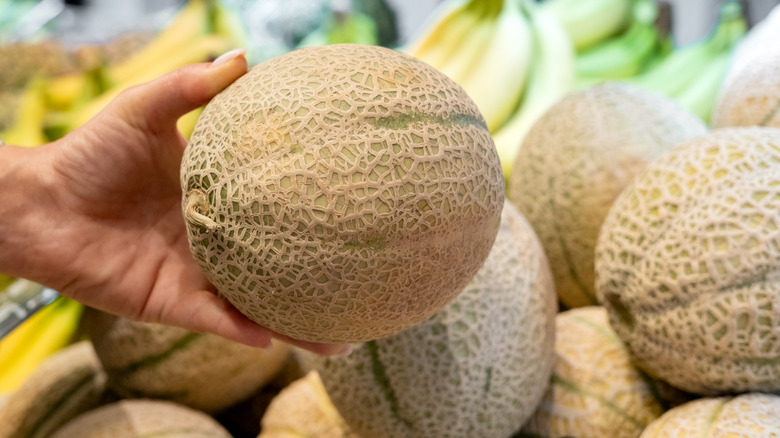The Simple Trick To Picking The Best Cantaloupe Every Time
There are few things more refreshing than a juicy cantaloupe when the weather's warm and the fruit's in season. Whether you cut it up into cubes, slices, or eat it straight from the rind, for the most juicy, tender bite, it's important to select a cantaloupe that's ripe. Unlike other fruits that ripen on the counter after you bring them home, cantaloupes don't ripen after picking. So, you need to choose wisely at the store or farmers' market. Luckily, there's a simple trick that can help you pick the best, most flavor-packed cantaloupe every time: Check for a stem to determine if it's a "clipped" versus "slipped" melon.
Slipped cantaloupes are those that have been allowed to naturally slip off the vine when they are optimally ripe, while clipped melons have been manually removed from the stem based on a farmer's judgment and production needs. Though clipped cantaloupes can certainly be close to juicy ripeness, since they are removed from the vine ahead of their natural "slipping" time, they are often removed too early — resulting in inconsistent ripening, and often subpar-tasting fruit. This means a harder texture and less flavor and sweetness than slipped melons. You can easily tell a slipped melon by flipping the cantaloupe to its stem end and looking for an indent where the stem used to be. If you see part of a stem (or a stem nub), however, then the fruit was cut, indicating it's likely less flavorful.
More ways to spot a juicy melon
While you should pick a slipped cantaloupe over a clipped one when given the chance, sometimes slipped cantaloupes aren't available. This can be especially true at the supermarket, where fruit and veggies are often picked less ripe than at farmers' markets due to factors like shipping. (And this is often why farmers' market produce tastes better.) While it's ideal to shop local for the ripest seasonal fruit, there are some additional ways to tell if a cantaloupe will be perfectly tender and juicy — even if it has a stem. Most notably, you can smell the opposite side (the blossom end) of a melon. Be on the lookout for a sweet, musty fragrance, which indicates ripeness. If the fruit has zero aromatics, it was probably clipped from the vine before it was ready.
Clipped or slipped, it's still usually a good idea to do the smell test. This is especially useful since melons can still soften or spoil off the vine. To tell if a cantaloupe is over-ripened or rotten, you can check for a fermented smell. However, with these tricks and knowledge, picking a good cantaloupe with a pleasantly floral aroma, no stem (if possible), and a bit of give when you squeeze it is easier. Once you select a ripe melon, you'll be well on your way to peeling the whole fruit like a pro and serving it in a variety of dishes, like mint and melon fruit salad, or even as an unexpected sweet topping for pizza.

